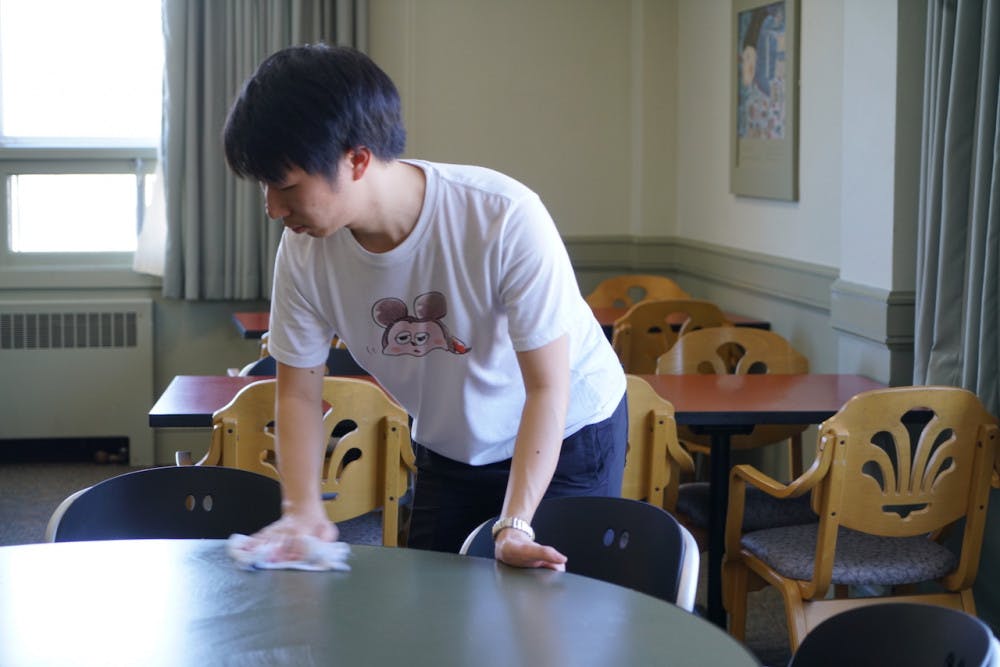Every weekday shortly after noon, students fill the Redfield Proctor dining room and sit down at one of more than a dozen different Language Tables for a served meal with professors and TAs. At each table, everyone including the student waiter that serves it, speaks only the designated language. The idea is straightforward — to provide students learning the foreign language a space to practice.
With more than 60 years of history, the student-run facility is now looking to extend its reach. On Mar. 4, students and faculty member of the computer science department sat down at the pilot Tech Table.
“We would like to extend this platform to non-language majors and would like to provide spaces for what Language Tables value and love, which are languages but also passion toward their learning subjects, the celebration of diverse cultures and inclusive platform for community engagements,” reads the Language Table’s official instagram account on the day.
Subin Cho ’19 and Stephen Chen ’19.5, Language Table managers for the academic year, shared that the idea of a Tech Table came partially from the fact that their technology manager, a computer science major, had not attended a Language Table yet.
The managers invited six students and one faculty member to the very first English-speaking academic table.
“Unlike the normal language tables, the focus of the table was not an improvement of a language (we didn’t speak in a computer language if you’re wondering),” one of the attendants Takao Shimizu ’20 said, adding that the conversation topics ranged from internship experiences and academic decisions.
“I’d love to see non-language language tables to continue because they would facilitate communications and build communities within departments,” Shimizu said. He also noted that because the Tech Table was open to non-majors and minors, undeclared first-years and sophomores could use the opportunity to explore the department and connect with each other.
Being from Germany, Professor of Computer Science Daniel Scharstein used to go to the German Table sometimes, and said that the Tech Table was successful.
“I think it’s a good idea,” he said. “And if they do one table like that for different departments — it doesn’t have to be tech, I don’t think there was anything special about it being a tech table — but if they have other things in addition to the languages, it’s a nice form that you don’t usually have.”
One of the main realizations that the managers had was that there is a lack of space for students to talk to professors in a non-academic setting. While the Language Tables have been providing students that for decades, Chen said that the the language-learning community represents a small fraction of the academic community, and the students who come to the Language Tables only comprise about 10 percent of the student body.
“So how do we expand that?” Chen said. “How do we open up the space where people can do that?”
Both Chen and Cho started working as Language Table waiters in the fall of 2016. Cho sees the Language Table as a particularly global and international space not only because of the diversity of languages represented, but also because of the way student attendees and student waiters bring encouragement to each other.
“What we deliver is not only the food, but also the spirit and the sense of language community,” Cho said, explaining that the same sense of community applied to the Tech Table, even though they are speaking English.
At the same time, Chen brought up that there has been some concerns over English-speaking tables at a space that’s otherwise solely dedicated to foreign language learning. Similarly, Scharstein said that English-speaking tables should probably be a small component of the initiative.
There are 15 different languages at the Language Tables, some of which are offered only seasonally, including Korean, Cantonese, Swahili, Vietnamese and ASL. While the food is prepared by Proctor Dining Hall, the entire process from recruiting student waiters to arranging daily attendance is completely organized by students.
“I’m just completely amazed that the whole thing is student-run,” Scharstein said.
The Vietnamese Table was a new addition to the Language Tables this spring term. Following the founding of Vietnamese Student Association (VSA) this year, Nathan Lam Nguyen ’19 reached out to the Language Table managers about having a table for the Vietnamese community on campus. Now every Friday, Nguyen serves as the Vietnamese waiter for the table.
“You don’t really need 20 students to set up a table,” Cho said. “As long as there are some regular attendants or there are some demand of setting up a table, you can ask us and come to us; be like ‘open up a table.’”
“There’s enough Vietnamese students on campus for us to be able to probably have a table going,” Nguyen said, explaining that he knows personally at least nine new Vietnamese first-years.
Consisting of 55 students serving tables of different languages, the work environment is a unique one in that student workers get to use a foreign language.
“It’s a very interesting space just because everyone here speaks at least two languages, and more likely than not they probably speak three, maybe four,” Chen said. “Meeting so many people who will go abroad, or have gone abroad or are from abroad really creates this interesting community within the workplace.”
The next pilot table in planning is the Japanese Heritage Table, which will take place on Mar. 18. According to the managers, new tables in the future could be either academic and cultural oriented. “The focal point of the pilot tables is to give the space to those people that are unrepresented,” Cho said.
Techies Unite: Language Table Initiative Expands Its Options

YVETTE SHI/THE MIDDLEBURY CAMPUS
Language Table manager Stephen Chen ’19.5 cleans up after a busy lunch period.
Language Table manager Stephen Chen ’19.5 cleans up after a busy lunch period.
Comments



